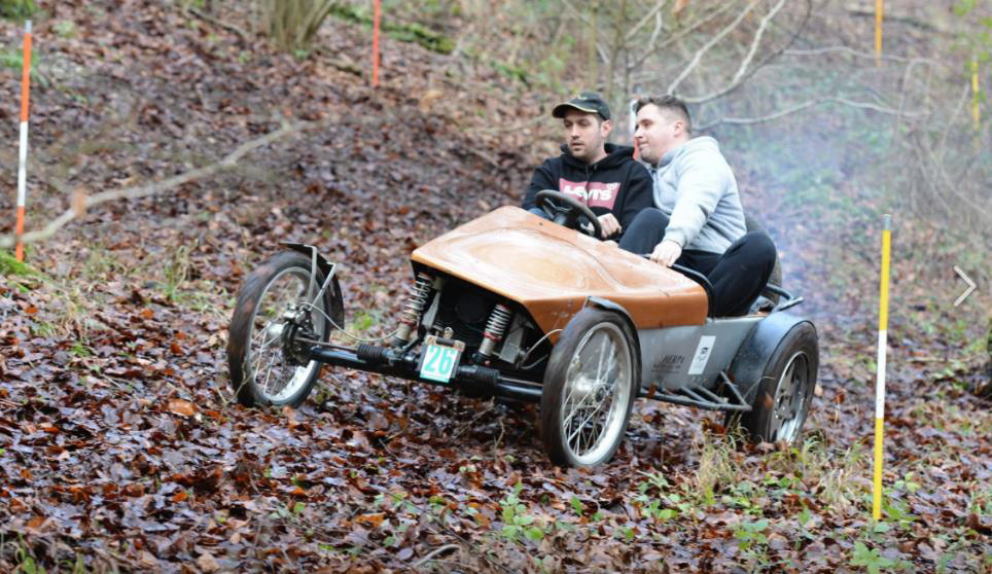If you wire up the small pump in series with the fan and controlled by a capillary thermostat, with it’s bulb inserted into the radiator fins the whole system becomes automatic. You park up the hot car and switch off after a section. The thermostat senses a hot radiator so it keeps the fan and the small water pump running until the radiator cools down. When it senses a cool radiator it switches off, saving your battery. Typically this takes less than a minute, and when you return to attempt the next section, both the radiator and the whole engine compartment is cool and ready to go. Small 12v water pumps and capillary thermostats are available for under £20 each on Ebay.
If you have cooling problems on blasting days obviously you want to use the biggest radiator that will fit, and it should be working well, in other words it will be fairly new or at least have been rad- flushed recently. Most important is the fan. Because we have almost no flow of air caused by the movement of the car, we need to force the air to flow. If the fan is well away from the radiator core the air will flow round the radiator, not through it. This is why most modern electric fans have a shroud which fits against the core, blocking the escape route and forcing the air to flow where it is needed. Look carefully at the specification of any fan you are buying, for example from the Demon Tweeks catalogue I find the following fans, all in 10” size, together with their air moving performance in cubic feet per minute: Spal 802 cfm, Revotec Slimline 929 cfm, Revotec High Performance 1150 cfm, Mishimoto Race 1600 cfm. The prices vary by only a small amount, all are under £90.
Perhaps the first thing you need is a temperature gauge, and do not fall for an electric one unless you are running an alternator, as their accuracy is often affected by falling battery voltage. Buy a capillary one which works at all times and is independent of outside influences. Another useful diagnostic tool is a multimeter fitted with a thermocouple, which can be taped to any part to measure temperature.
During the trial do everything to keep the underbonnet temperature down, try to get the coolant temperature down to 70 degrees or so before starting each section. If this means leaving the fan running all day, then so be it. If this runs the battery down then replace the battery and carry a spare for changing at lunchtime, or charge it up using jump leads off your tow vehicle. I have the fan(s) installed so they blow forwards, taking the hot air away from the engine compartment, and I have fans mounted back and front of the radiator.
Never leave the car running when the engine is not needed, it just makes things worse. Take a good look under the bonnet and see where the heat is likely to affect the fuel system, for instance in a non cross flow engine, (exhaust the same side as the carb(s)), how near are the exhaust manifold pipes to the float chambers? Add shields to prevent radiant heat transmitting directly from the pipes to the fuel system, and wrap the pipes in heat shielding tape to carry the hot gases outside the bonnet area.
How can you be sure that your problems are heat related and fuel system related, not from some other area like the coil or condenser getting warm? Do some simple tests, when the problem occurs remove the bonnet, feel the float chambers and if they are even blood heat you may have a problem. Carry a cloth and a bottle of cold water and wrap the float chambers in the wet cloth. Wait a bit, leave the bonnet off and try again. If the problem has improved you have probably found it.
If you are still convinced that the problems might lie elsewhere buy a Kilovolt Tester and check the plug lead voltages. This pocket sized device costs about £80 and is a fine diagnostic tool. I carry one in my van if you want to borrow it. If you have ignition problems the tester will show them up, if not, back to the fuel heat problem.
The classic symptom of “the hot fuel problem” is when the engine starts badly, runs poorly with misfiring, and sorts itself out after a short time of running, provided that the engine is under a light load, such as a trickling section, or an easy progress to the next section. The reason is that cool fuel from the tank has arrived at the float chamber and displaced the hot boiling fuel. This leads to another solution used in some production cars. On some SU carbs there is a second, slightly smaller, fuel pipe alongside the main fuel inlet to the float chamber. This is used to create a re-circulating fuel system, bringing constant supplies of cool fuel from the tank, and returning the warmed fuel through a second fuel line. It is quite simple to achieve, and low cost, but you need to install a return line to the tank which will require the installation of a second tank connection. You will also need to buy different float chamber top(s). Remember that only metal fuel pipes may be used inside the passenger compartment.
Finally do try and diagnose your problems whilst at a trial, you will find it difficult if not impossible to re-create the conditions at home.

